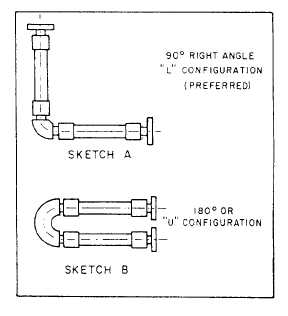Filter/Separator
The filter/separator is a two-stage unit
consisting of a coalescer stage and a separator
stage within a single housing. Each stage is made
up of replaceable elements, the number of which
is determined by such considerations as the
capacity of the elements in gallons per minute
(gpm) and the elements dirt retaining properties.
Coalescer elements filter solids from the fluid and
cause small particles of undissolved water to
combine (coalesce) into larger drops of water that,
because of their weight, will settle in the
filter/separator sump. Separator elements are
provided to remove any remaining free water that
has not coalesced. Water that accumulates in the
filter/separator sump is removed through a drain
line, either automatically or manually.
In-Line or Cone Filter
In-line or cone filters have conical-shaped fine
mesh screen or perforated metal sheet that is
inserted into the system pipe and secured by a set
of flanges. Its system application determines
whether it is considered a filter or strainer. It is
most commonly used in seawater systems, where
it is considered a strainer. This type of filter is
prohibited in fuel systems.
MAINTENANCE
Proper operation of filters, strainers, and filter
separators is essential for satisfactory gas turbine
and diesel engine performance. Besides clogging
the systems with foreign matter, continued
operation with unfiltered fluids results in
accelerated pump wear and system degradation.
Routine maintenance of filters, strainers, and
filter/separators is adequately covered in NSTM,
Chapter 541, “Petroleum Fuel Stowage, Use, and
Testing,” paragraphs 541-8.51 through 541-8.59.
PIPING
The control and application of fluid power
would be impossible without a suitable means of
conveying the fluid from the power source to the
point of application. Fluid lines used for this
purpose are called piping. They must be designed
and installed with the same care applicable to
other components of the system. To obtain this
desired result, attention must be given to the
various types, materials, and sizes of lines
available for the fluid power system. The different
types of lines and their application to fluid power
systems are described in the first part of this
section. The last part of this section is devoted
to the various connectors applicable to the
different types of fluid lines.
IDENTIFICATION OF PIPING
The three most common lines used in fluid
power systems are pipe, tubing, and flexible hose.
They are sometimes referred to as rigid (pipe),
semirigid (tubing), and flexible piping. In
commercial usage, there is no clear distinction
between piping and tubing, since the correct
designation for each product is established by the
manufacturer. If the manufacturer calls its
product pipe, it is pipe; if the manufacturer calls
it tubing, it is tubing.
In the Navy, however, a distinction is made
between pipe and tubing. The distinction is based
on the method used to determine the size of the
product. There are three important dimensions
of any tubular product—outside diameter (OD),
inside diameter (ID), and wall thickness. The
product is called tubing if its size is identified by
actual measured outside diameter and by actual
wall thickness. The product is called pipe if its
size is identified by a nominal dimension and wall
thickness.
PIPING MATERIALS
The pipe and tubing used in fluid systems
today are commonly made from steel, copper,
brass, aluminum, and stainless steel. The hose
assemblies are constructed of rubber or Teflon.
Each of these materials has its own distinct
advantages or disadvantages, depending upon its
application.
Figure 9-50.—Types of flexible hose installations and fittings.
9-32

